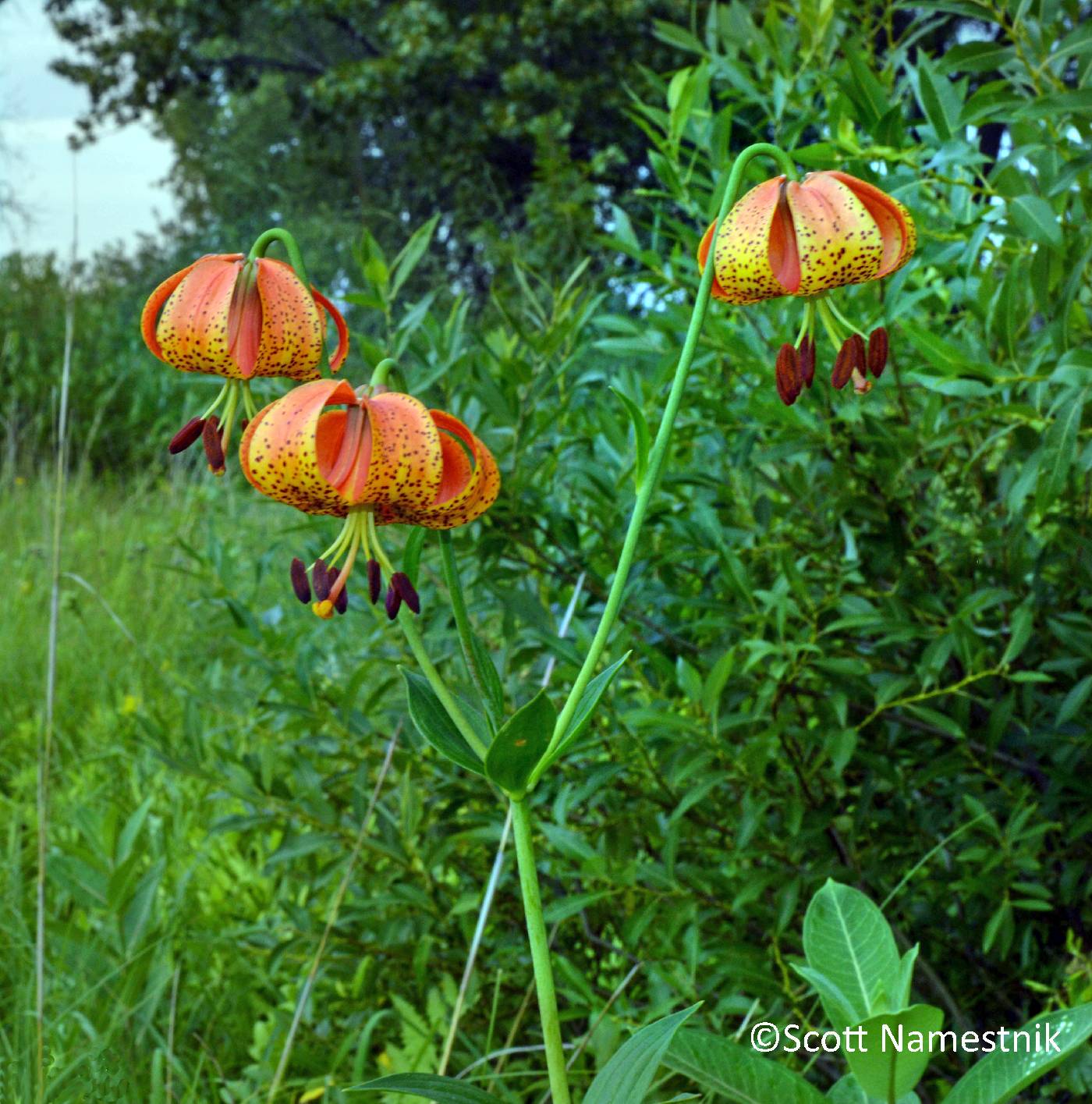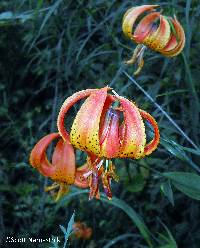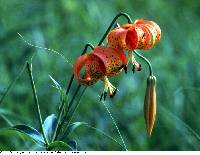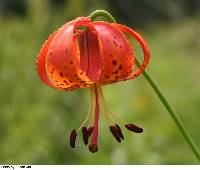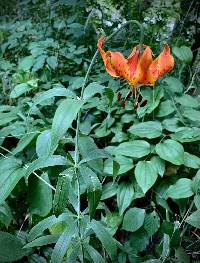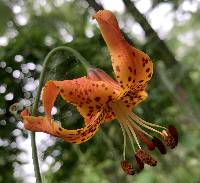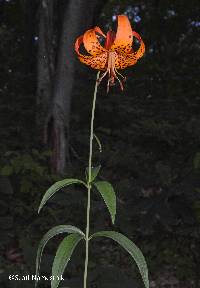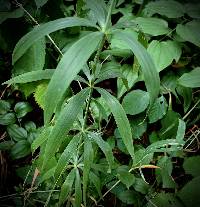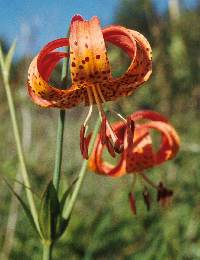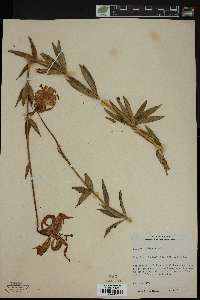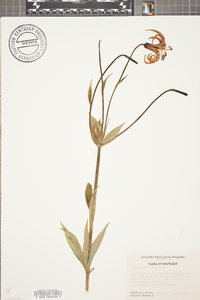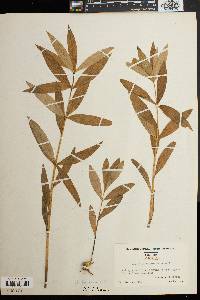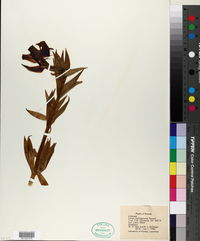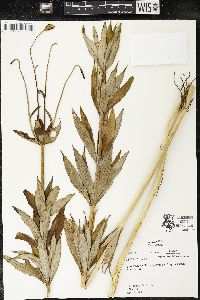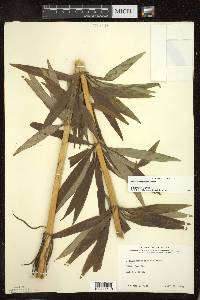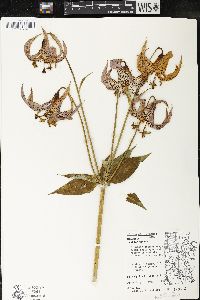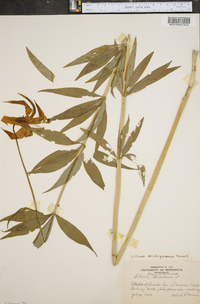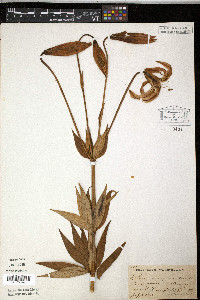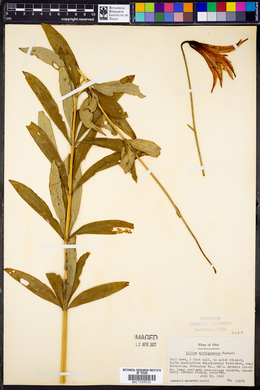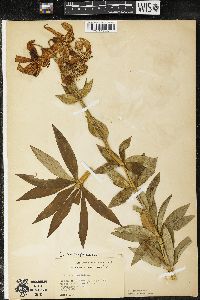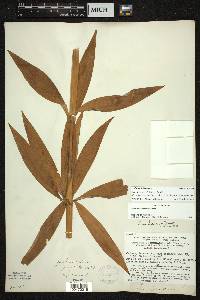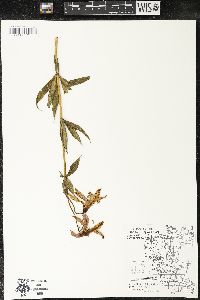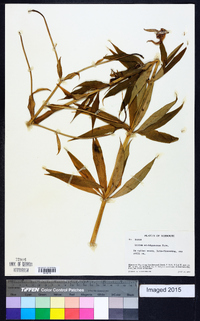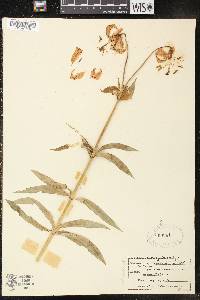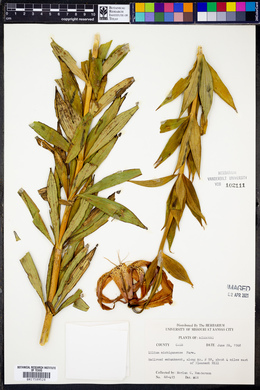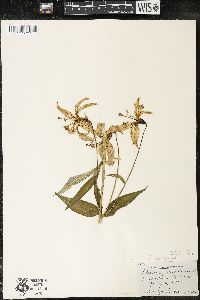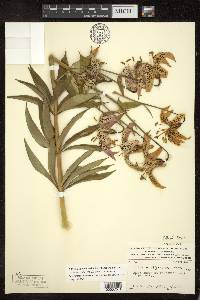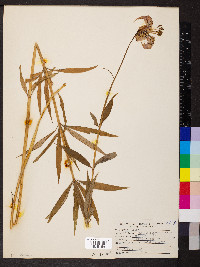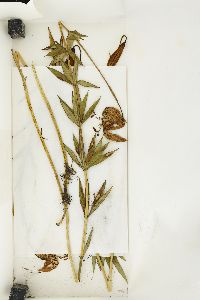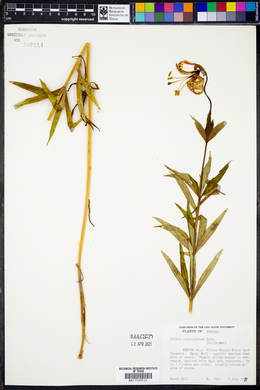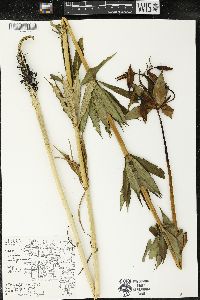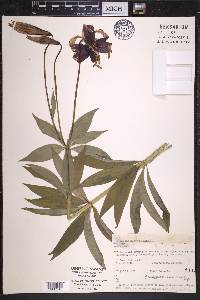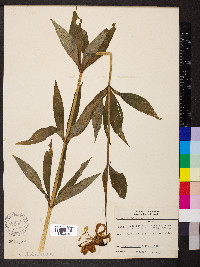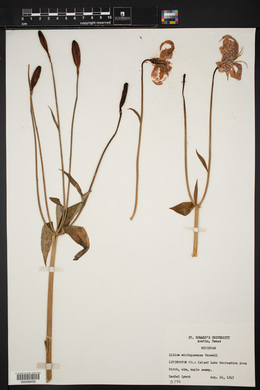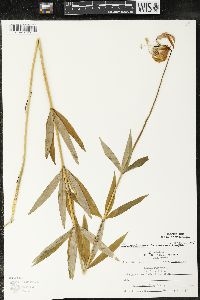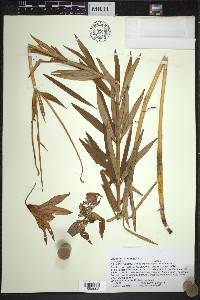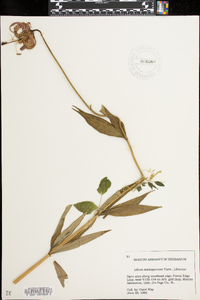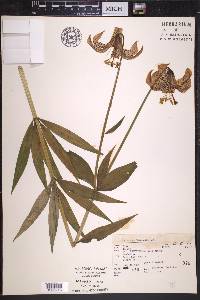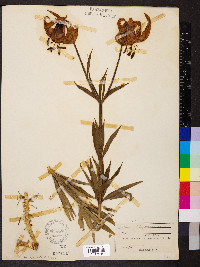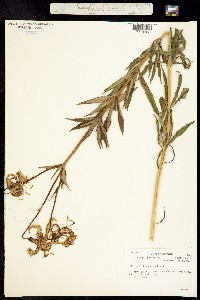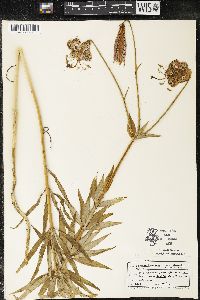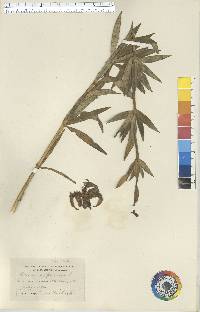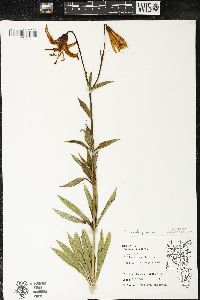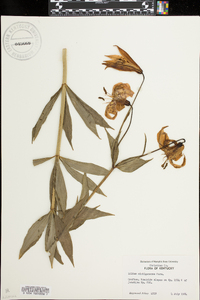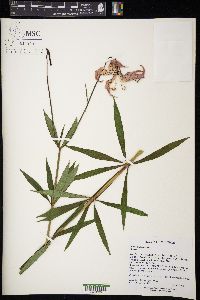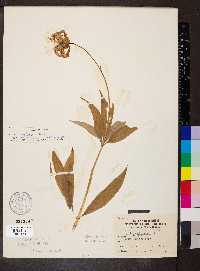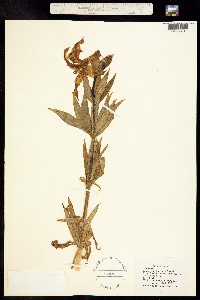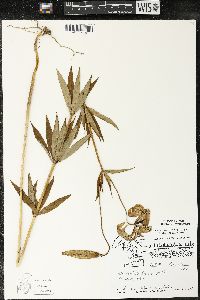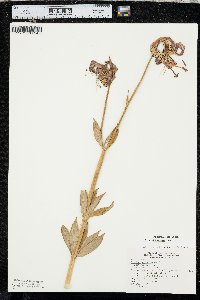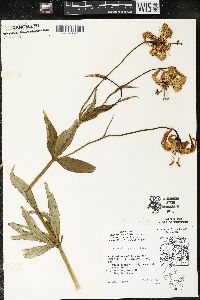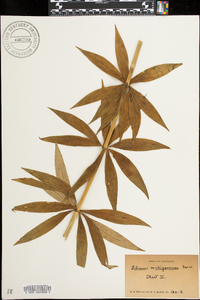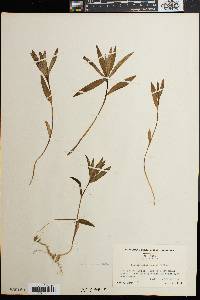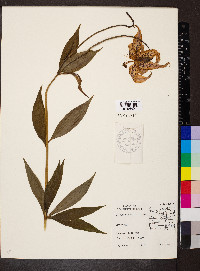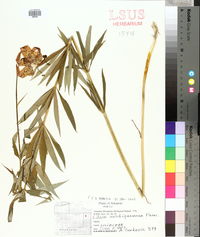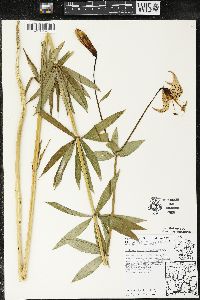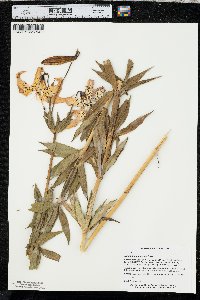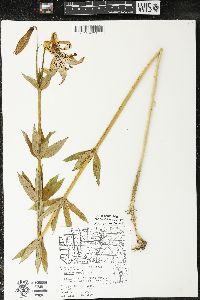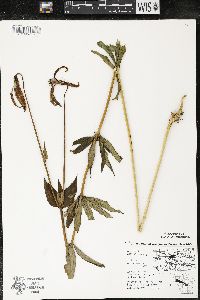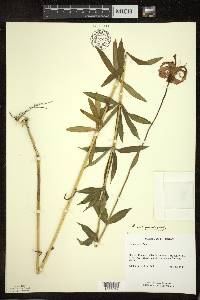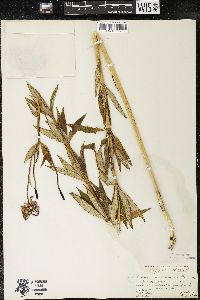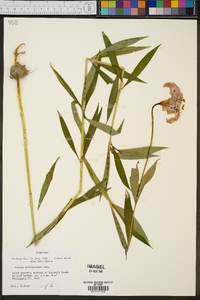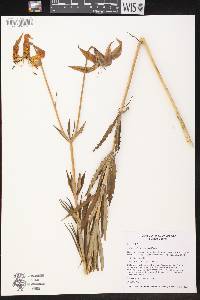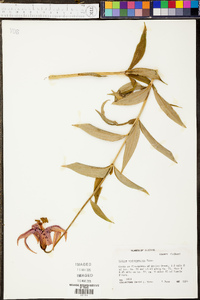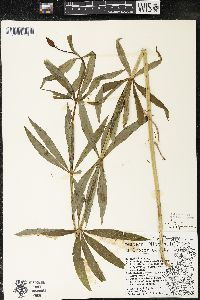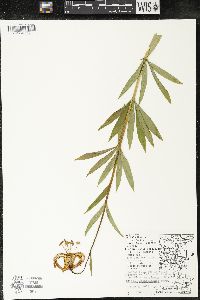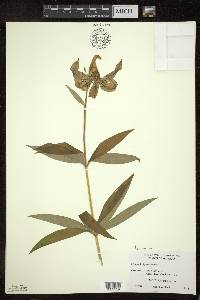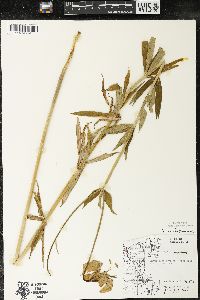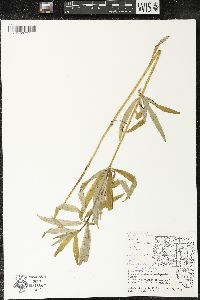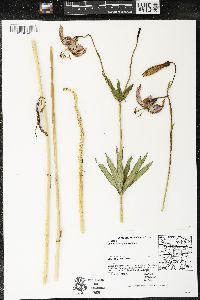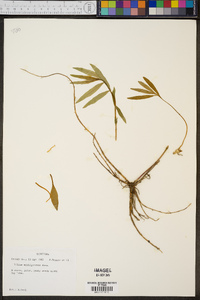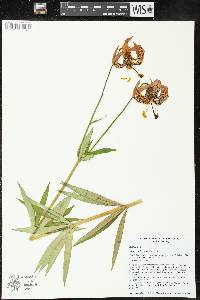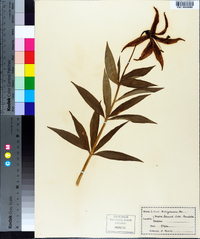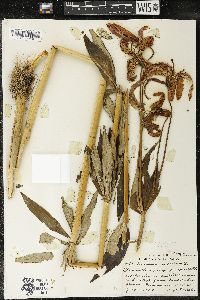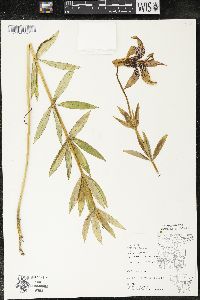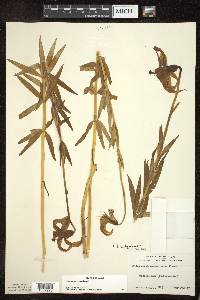Lilium michiganense
|
|
|
|
Family: Liliaceae
Michigan Lily
[Lilium michiganense var. umbelliferum] |
Bulbs usually yellowish, rhizomatous, unbranched, 1.6-5.8 × 4.9-14.1 cm, 0.3-0.5 times taller than long, 2 years´ growth evident as annual bulbs, scaleless sections between these 2.6-6.2 cm; scales unsegmented, longest 1-3 cm; stem roots present or absent. Stems to 1.9 m. Buds rounded in cross section. Leaves in 4-12 whorls or partial whorls, 3-13 leaves per whorl, ± horizontal or ascending in sun, drooping at tips, 4.6-15.3 × 0.6-2.3 cm, 3.5-13.7 times longer than wide; blade narrowly elliptic, occasionally linear or slightly lanceolate, margins not undulate, apex acute, acuminate in distal leaves; principal and some secondary veins impressed adaxially, veins and margins noticeably roughened abaxially with tiny ± deltoid epidermal spicules, especially on proximal leaves. Inflorescences racemose, 1-11-flowered. Flowers ± pendent, not fragrant; perianth Turk´s-cap-shaped; sepals and petals reflexed 1/4-2/5 along length from base, yellow-orange or sometimes orange-yellow or orange proximally, red-orange distally, with maroon, often large spots, red-orange or occasionally red or orange-red abaxially, not distinctly clawed; sepals not ridged abaxially, 5.5-9.3 × 1.2-2 cm; petals 5.3-9.1 × 1.5-2.2 cm; stamens moderately exserted; filaments parallel at first, then ± widely spreading, diverging 13°-23° from axis, pale yellow-green; anthers magenta or occasionally pink-magenta, 0.6-1.3 cm; pollen orange-rust, sometimes orange, rust, or rust-brown; pistil 3.4-6.5 cm; ovary 1.5-2.9 cm; style red entirely or only distally; pedicel 11-22 cm. Capsules 2.8-5 × 1.5-2.6 cm, 1.4-2.8 times longer than wide. Seeds not counted. 2n = 24. Flowering summer (mid Jun--Jul). Tallgrass prairies, streamsides, swamps and bottoms, moist woodland edges, lakeshores, ditches along roads and railways, often calciphilic; 100--600 m; Ont.; Ark., Ill., Ind., Iowa, Kans., Ky., Mich., Minn., Mo., Nebr., N.Y., Ohio, Okla., S.Dak., Tenn., Wis. B. Boivin and W. J. Cody (1956) proposed uniting Lilium michiganense and L. superbum as subspecies of L. canadense on the basis of overall similarity, though it is now well accepted that L. superbum does not belong there. There can be little doubt as to the close relationship between L. michiganense and L. canadense, however, and vegetatively the two are often indistinguishable. Hybrid intermediates occur across a wide band where the distributions meet in central Ohio and northwestern New York (R. M. Adams and W. J. Dress 1982). It would not be unreasonable to include L. grayi and treat them as subspecies, but floral differences among the three are comparable to those between other species in the genus. Farwell´s proposed varieties uniflorum and umbelliferum were described from young plants with single flowers and umbellate inflorescences respectively, but young plants with these characteristics are found throughout the range of this species. Plants examined from east-central Tennessee (e.g., Wayne and Coffee counties) that were previously referred to Lilium michiganense are L. superbum in some cases, in others L. canadense perhaps introgressed with L. michiganense. The Michigan lily often co-occurs in tallgrass prairies with Lilium philadelphicum; here as everywhere it usually blooms much later. However, it flowers earlier than L. canadense where their ranges are contiguous in Ohio (E. L. Braun 1967). Lilium michiganense is pollinated primarily by swallowtail butterflies; in the southern part of its range these include the pipevine [Battus philenor (Linnaeus), family Papilionidae]. Great spangled fritillaries [Speyeria cybele (Fabricius), family Nymphalidae] also visit this species and carry its pollen, though it is unlikely that this brushfooted butterfly is a major pollinator.
Perennial herb with a bulb flowering stem to 2 m tall Leaves: in four to twelve whorls or partial whorls (three to thirteen per whorl), stalkless, more or less horizontal or ascending with drooping tips, 4.6 - 15 cm long, 0.6 - 2.2 cm wide, narrowly elliptic to occasionally linear or lance-shaped, minutely toothed. Inflorescence: an upright, terminal cluster (raceme) of one to eleven flowers raised on a stout stalk. Flowers: long-stalked, more or less nodding, yellowish orange to reddish orange with reddish spots, 5 - 8 cm long, fused at the base, Turk's-cap-shaped, with six tepals that curve backward to nearly the base. Stamens six, exserted. Filaments elongate. Anthers magenta to occasionally pinkish. Style mostly red. Fruit: a three-valved dehiscent capsule, upright, brown at maturity, to 5 cm long, more or less oblong egg-shaped with a constricted base. Seeds numerous and flat. Bulb: rhizomatous, usually yellowish, egg-shaped, scaly. Similar species: Lilium lancifolium is similar but has alternate, lance-shaped leaves that bear dark bulblets on the upper stem. Lilium philadelphicum is also similar but has only a few whorls of leaves, upright (not nodding) flowers with clawed tepals, and an overall height of less than 1 m. Flowering: late June to early August Habitat and ecology: Commonly found in several habitats, including prairies, moist woodlands, calcareous springy fens, and the thickets at prairie edges. Occurence in the Chicago region: native Notes: Swallowtail butterflies are the primary pollinators of Lilium michiganense. Lilies, as a whole, are highly regarded for their beauty and are of great commercial importance. Thousands of hybrids have been developed. However, native North American species do not thrive well in gardens and many suffer from excessive collecting. It is best not to remove them from the wild. Etymology: Lilium means lily. Michiganense means "of or from Michigan." Author: The Morton Arboretum Much like no. 7 [Lilium superbum L.], but usually spiculate-scabrous along the margins of the lvs and on the veins beneath; anthers mostly 5-15 mm; 2n=24. Bogs, meadows, low woods, and wet prairies; w. N.Y. and s. Ont. to Man., s. to Tenn. and Ark. June, July. Gleason, Henry A. & Cronquist, Arthur J. 1991. Manual of vascular plants of northeastern United States and adjacent Canada. lxxv + 910 pp. ©The New York Botanical Garden. All rights reserved. Used by permission. From Flora of Indiana (1940) by Charles C. Deam Infrequent throughout the northern part of the state and probably rare in the southern part or even absent from the southeastern part. It has been confused with the preceding species [Lilium canadense] and our knowledge of its distribution and habitat can be now ascertained only from field studies or from existing specimens. Almost all of the reports for lilies in Indiana must be ignored on account of the recently acquired knowledge of the genus. Lilium michiganense grows in moist prairie habitats, in mucky soil about lakes and in low woods, and in moist, black soil along roadsides and railroads. Locally it may be common over a small area. When once established it is very persistent, competing successfully with blue grass sod. I have known it to be a common plant for possibly 25 years in black, moist soil along the railroad through the old prairie north of Poneto, Wells County. It is to be noted with this species, as with the others, that the available amount of moisture has a marked effect upon the number of flowers on the plants. Where it is driest, most of the plants will have only one flower. .…… Indiana Coefficient of Conservatism: C = 5 Wetland Indicator Status: FACW |
|
|
|

